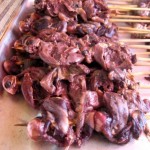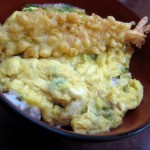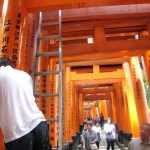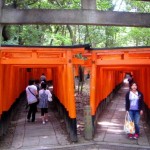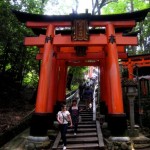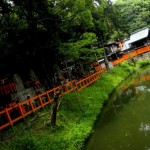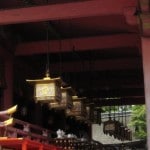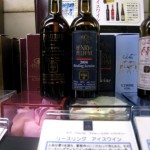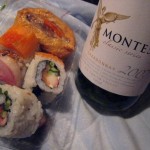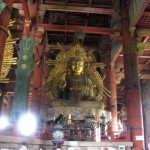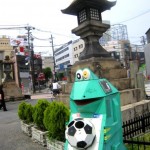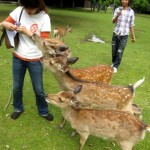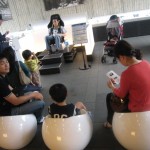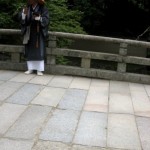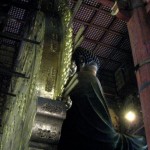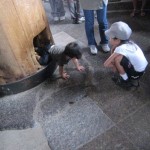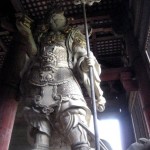I woke up to another lovely blue sky and hopped on the subway for a day trip out of the city. My first stop was approximately twenty minutes south of the city center at the village of Fushimi which is home to another one of the countries most famous shrines.
Approaching the shrine, local delicacies are sold at the roadside, including barbecued sparrow and inari-sushi (sweetened sushi rice wrapped in fried tofu), which is said to be a favorite of the fox. I was a bit light headed and decided it would be best that I stop and eat brunch before continuing on with my day. I found a little hole in the wall restaurant where the most adorable little Japanese grandmother hobbled around the tiny dining room to show me where I should sit on the floor. She had a high pitched little squeak of a voice which was masked by the rasp in her throat. She had approximately three teeth and hundreds of wrinkles across her aged face. She brought me several hot glasses of green tea throughout my short stay at her humble little restaurant. I had a delicious bowl of rice covered with creamy scallion and garlic scrambled egg topped with shrimp tempura.
Fushimi Inari Taisha sits at the base of Mt. Inari, and includes trails up the mountain. It is dedicated to Inari, the Japanese fox goddess. Foxes (kitsune), regarded as the messengers, are often found in Inari shrines. This particular shrine is the head shrine (taisha) for 40,000 Inari shrines across Japan. Stretching 230 meters up the hill behind it are thousands of bright orange torii gates. Merchants and manufacturers worship Inari for wealth. Bright orange torii lined footpaths offer a distinctive and rather enchanting part of the visit. These giant gates create orange tunnels leading to various shrines along the mountain. People jokingly tell you to watch your fingers as you walk through the torii gates as legend says fox spirits are able to possess people by slipping through their fingernails. The shrine draws several million worshippers over the Japanese New Year. It was reported in 2006 by the local police that 2.69 million people visited the shrine over a three day time span.
I spent forty minutes walking through thousands of these orange gated tunnels. I stopped several times along the hike to stare out at the forest, shrines and little fox statues which snarled at me, frozen in time. I stopped for several minutes to wander through a cluster of hundreds of tiny shrines. If the particular shrine had been visited recently it would have a wild assortment of gift piles at its base; apples and oranges, stacks of coins, and long and colourful origami garlands which swayed in the gentle mountain air. At the top of this shrine studded staircase I walked along a crystal clear pond surrounded by trees. On the other side of the water stood an open shrine where long candle flames blackened in the air. I stood beside a pilgrim who lit one of these candles and prayed with her head bowed for a few moments of silence. My arms broke out into goose bumps even though my face was sweating from the heat coming off these glowing candles. I walked back to the base of the mountain, through thousands of tori while staring up at the blue sky and calmly breathing in the fresh air.
I hopped on another train headed for the Unesco World Heritage Site filled city of Nara. The original city of Nara, Heijo-kyo, was modeled after the capital of Tang Dynasty China (present day Xi’an). Nara became the capital of Japan from 710 to 784. Since the city is typically overshadowed by its more famous neighbor Kyoto, Nara is omitted from many a time-pressed tourist’s itinerary. Along with the development of Heijo-kyo, Nara flourished under the influence of Buddhism, leading to the creation of an enormous number of cultural assets, buildings and books, many of which are preserved today. Nara has the largest number of buildings designated National Treasures in Japan.
Most of Nara’s sights, including temples, shrines and famous deer, are concentrated in Nara Park, a wide, pleasant space of greenery. According to legend the god of the Kasuga Taisha came riding a white deer in the old days, so the deer enjoy protected status as envoys of the god; however, based on their current behavior, either the deer have lost the job, or this particular god has taken an extremely passionate interest in cookies from tourists, empty food wrappers and harassing shopkeepers. There are over 1200 free running deer in the park which is why many people automatically associate the city with these animals.
From Nara Station I walked ten minutes to the entrance of the park and headed straight for the cities two famed pagodas. Kofuku-ji has a three story and five story pagoda, historically, the latter has contended with Kyoto’s Toji for the title of Tallest Pagoda in Japan. The two pagoda’s stand on opposite ends of a vast gravel filled space where hundreds of adult deer and their little fawns rub up against tourists in hope for a snack.
I walked through the entire park, prancing across several streams and chasing a few stunned deer. I spread out my arms like an airplane and tried to fly over the trees with no luck. I then took a quick turn down the main street which leads to the cities famed Todai-ji Temple. The street was jam packed full with ice cream shops, tourists and hungry deer. I stood in front of the massive Nandaimon Gate and watched a group of Japanese school girls scream in fright as two deer circled around them and tried to lick their faces.
Todai-ji Temple was built in the Nara period at the behest of Emperor Shomu. The temple was officially positioned as one of many state established provincial temples. However, since the chief object of worship of the temple is Vairocana Buddha (Buddha that shines throughout the world like the sun), a magnificent temple was built to reflect this importance. The statue of Vairocana Buddha is made from cast bronze, which was then plated with gold. The statue was consecrated in 752 and stands in the center of Todai-ji, the largest wooden structure in the world.
A path leads up to the entrance of Todai-ji and I couldn’t help but wonder if giants at some point lived in this massive building. Perfectly cut bright green grass surrounds the temple entrance and features several shrubs and flower gardens. There was an excitement in the air as everyone hustled towards the entrance of the building. And then all of a sudden I was walking through the doors. I waited as my eyes slowly adjusted to the darkness within. As my eyes acclimatized themselves to dimly lit interior my jaw dropped. Directly in front of me stood one of the worlds largest Buddha statues. The Buddha’s calm face stared out into the distance and its massive hand gestured towards the buildings entrance. The Buddha’s total height is roughly 50 meters from the ground to the tip of its head. A few interesting anatomical Buddha measurements: head eighteen feet tall, eye four feet wide and ears a whooping eight feet long.
I stared gawking up at this massive bronze as hundreds of people filed through the door to leave gifts, light incense and pray at the feet of the Vairocana. I imagined this huge Buddha coming to life. Slowly the eyes would blink, the huge hands would push down onto the ground and it would stand up, bursting right through the roof of the world’s largest wooden building and let out a long moan. Sitting for over 1500 years in one position requires a bit of a stretch and grunt I’d say.
The building also contains four other giant statues. Sitting beside the Vaircona are two bright gold Buddha’s about two thirds smaller than their more impressive and more famous friend. I fell in love with the two warrior statues which towered at the back of the temple. These two larger than life soldiers have faces full of rage and hold up their swords in protection of the Buddha’s they protect.
There is a stand inviting you to sponsor a tile in order to help with the upkeep of the temple, and English-language fortune scrolls. Just before the souvenir area, behind and to the right of the building, is a wooden column with a small hole carved through the bottom. Enlightenment is reportedly promised to anyone who can squeeze through this hole. In practice, this means a lot of kids have enlightenment in store, and all but the skinniest adults can only look on in envy. A large crowd had gathered around the pole and I was utterly shocked by what I saw. At first two little three year olds crawled through the hole. Once on the other side they stared up their parents and smiled. Then a rather adventurous seventy year old woman poked her head through the hole. Her husband grabbed hold of her arm and for the next minute she grunted as he pulled her through the tiny hole with all his might. She collapsed on the floor after safely making it through. I assumed she had broken a few ribs but had to laugh when she jumped up off the floor, threw her hands in the air and hugged her husband as the crowd cheered.
As I stepped out of the building I noticed a group of people huddled around a statue to the left of the entrance. This is a statue of Yakushi Nyorai. Though a bit scary looking on first glance, it’s actually a Buddha of medicine and healing. Pilgrims rubbed their hands all over the wooden Buddha’s legs and arms while quietly praying for good health for themselves and their loved ones.
I spent a few more minutes skipping through Nara Park and chasing several hundred deer before hopping back on the next train bound for Kyoto. At Kyoto Station I took the escalator to the bottom two floors where an amazing food emporium is located. Starting at the bottom floor I walked through a massive high end grocery store where I fiddled through the wine department in search of the perfect bottle for my dinner. I noticed a selection of mini bottles and laughed out loud when I saw two wee bottles of Iniskillen and Henry of Pelham Niagara Ice Wine. This home grown Canadian treat sells in mini bottles in Japan for twenty five dollars a pop. I now completely understand why the Japanese tourists who take over Niagara Wine Country in the summer and fall buy boxes of the stuff to take home when they visit.
I found a fifteen dollar bottle of Montes Estate Chardonnay from Chile and stood in line to purchase it when an employee of the store ran in front of me and knocked the bottle out of my hands. It crashed to the floor and the entire room went silent. I felt incredibly awkward as I didn’t know what to say. Everyone stared at me as the manager rushed to my side. In less than thirty seconds the mess had been cleaned up and I was given another bottle. I stood back in line after bowing my thank you to the manager. He stared at me and laughed and said, “you no pay.” I was shocked that I was being given a free bottle of wine simply because I was knocked off balance by an employee. Back home I would have been given another bottle to purchase, not given another bottle to take home free of charge. Japan was even more beautiful in my eyes at that very moment.
I took the escalator up to the next floor which was insanely busy. This floor is full of “take home, ready prepared meals” of the highest quality. It was around 6pm at this point and I could tell all of the women around me were looking for a quick and healthy Saturday night meal for their family. I tasted a few Chinese pork and shrimp dumplings as I squeezed through the main aisle. I settled on a box of three inari sushi (fried sweet bean curd packets filled with rice, carrot and shitake mushroom). My last stop was the “I Love Sushi” stand which had a twenty or so different freshly made sushi rolls on sale for four dollars a roll. I ordered three to take home. The first roll contained tuna sashimi, lettuce and avocado. The second, salmon sashimi, cream cheese and cucumber. The last roll contained thinly sliced roasted duck breast, leek, cream cheese and roasted sesame.
Holding my grocery bag in one hand and holding my other finger up to the Kyoto bus map I must have looked puzzled. A University student noticed my awkward frustration and called over to me. He took me to the correct bus stop and chatted with me until it arrived. He was a funny little guy. A student of International Culture who had never been outside of his country. I asked him what he had been doing all day in Kyoto (since his apartment is in Osaka). He responded, “I had an erection all day.” I stared at him in shock not knowing what to say. He continued to chit chat when I finally realized he had meant to say, “I had a lecture all day.” Outrageous moments abound when Lost in Translation.
Once back in my room I had a quick shower and packed up my things trying my best to avoid the uber awkward perma-nerd who I had spent the last two days sharing the room with. If you looked up nerd or geek in the dictionary you would see this guys face. He introduced himself to me at first by shaking my hand and saying, “I was home schooled, I love comics and my favorite animal is the butterfly.” Heaven help him. Whenever I’d walk into the room he would be sitting on his bed watching anime on his laptop. He told everyone at the hostel one night that he had left Colorado and flown to Kyoto to see “the love of his life.” He had apparently been in love with this girl for the past three years and now that she teaches in Kyoto he thought it would be a great opportunity to woo her. Mind you, he didn’t tell her he was coming to visit. I gathered she clearly wasn’t interested in him when he told us one night on the balcony that he had spent four hours waiting for her at fountain. A famous meeting spot in the city that she had agreed to. I asked him, “didn’t you wonder, ‘maybe she isn’t coming to meet me,” after the first two hours?” I told him in the future he should never wait for anyone for over an hour. We were all floored when he said, “oh no she wanted to meet up with me she just must have gotten lost.” He just didn’t get it. I’m sure it must have been very difficult for a girl who had been living in Kyoto for the past ten months to find the cities most famous landmark water fountain. I figured I’d secretly miss this awkward social misfit, and I did, for a brief moment as I left the hostel early the next morning. Osaka bound.
